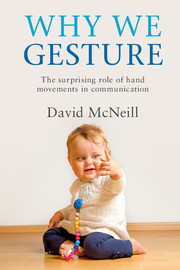8 - Brain
from Part II - Phylogenesis, ontogenesis, brain
Published online by Cambridge University Press: 05 December 2015
Summary
We now look at the thought–language–hand brain link itself and consider some of its properties. A brain model is the first topic; then evidence from cases of aproprioception, commissurotomy and speech disorder; finally, a working memory that evolved in the origin of language specifically for gesture-orchestrated speech in gesture–speech units.
Brain model
The thought–language–hand link is a neurogesture–speech system criss- crossing the brain to engage the right and left sides as well as the anterior and posterior parts of the brain in a choreographed operation.
Wernicke's Area is not limited to comprehension. It supplies categorial content, not only for comprehension (as classically supposed) but for the creative production of verbal thought. If this content crosses to the right hemisphere, which seems particularly adept at creating sui generis metaphors and imagery and capturing discourse content (McNeill and Pedelty 1995), the right hemisphere could play a role in the creation of growth points (GP), which require content from context, imagery and sui generis metaphors—the right hemisphere specialties to which Wernicke's Area sends linguistic categories. Kelly et al. (2004) observe evoked response effects (N400) in the right brain when subjects observe speech–gesture mismatches.
All this could recross to Broca's Area to create a GP. A germane result is Federmeier and Kutas (1999), who found through evoked potential recordings different information strategies in the right and left sides of the brain—the left they characterized as “integrative,” the right as “predictive.” These terms relate to the hypothesized roles of the right and left hemispheres in the generation of GPs. Broca's Area is the site of Mead's Loop and self-response, an integrative process. The GP is integration par excellence. The right hemisphere for its part offers the left hemisphere imagery, cohesive discourse and linguistic content related to imagery, and fits the predictive role.
The prefrontal cortex has a role in forming fields of equivalents and psychological predicates. Language depends on processes of choice and differentiation and these the prefrontal cortex provides. This too could go to the right and left hemispheres.
Finally, rhythmicity (Duncan 2005) and interactional entrainment (Gill 2007) point to a circulation in and out of the cerebellum (see Lieberman 2002).
- Type
- Chapter
- Information
- Why We GestureThe Surprising Role of Hand Movements in Communication, pp. 157 - 184Publisher: Cambridge University PressPrint publication year: 2015



